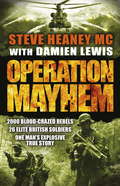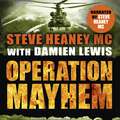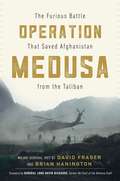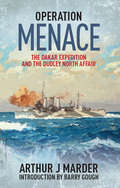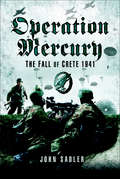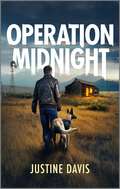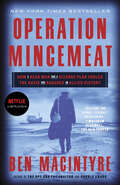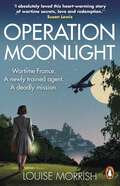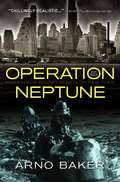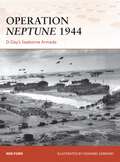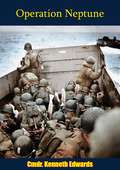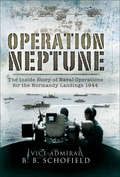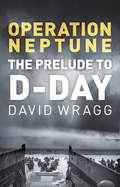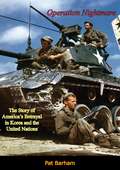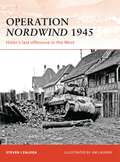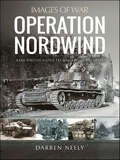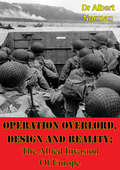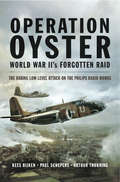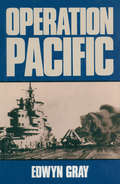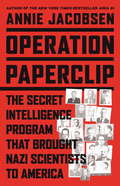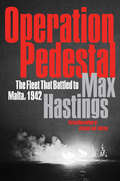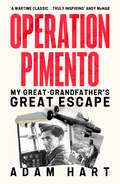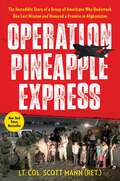- Table View
- List View
Operation Mayhem
by Damien Lewis Steve HeaneyOPERATION MAYHEM is the first ever account of a truly epic elite forces mission: one of the most highly decorated in modern military history. Airlifted deep into the heart of the African jungle in the midst of a bloody civil war, twenty-six operators from the secret British unit X Platoon were sent into combat against two thousand rebels - being used as bait to lure the enemy into a decisive, do-or-die battle. High on blood-lust, voodoo and drugs, the rebels were notorious for their brutal savagery. Equipped with captured armour, heavy machine-guns and grenade-launchers, they vastly outgunned the men of X Platoon - who were kitted out with pitiful supplies of ammunition and malfunctioning rifles, plus no body armour, grenades or heavy weaponry. Intended to last just days, the mission mutated into a desperate siege, as the men of X Platoon - more formally known as the Pathfinders - faced what the rebels dubbed 'Operation Kill British'. Half-starved, surviving on giant African snails, fungi and other bush tucker, this handful of elite warriors were forced to make their stand unaided and alone. They fought using grenades made from old food-tins and 'punji fields' - rows of vicious sharpened bamboo-stakes - as the locals joined forces with them to defend against the onslaught. Sergeant Steve Heaney was awarded the Military Cross for taking control of the battle after X Platoon lost their commanding officer. His story is full of the rough-and-ready humour and steely heroics with which these elite soldiers carried out operations far into hostile terrain. The ferocious close quarter combat at the village of Lungi Lol brought to an end the horrific, decade-long civil war in Sierra Leone. OPERATION MAYHEM is the first ever account of this untold true story - one fought and won deep behind enemy lines.
Operation Mayhem
by Damien Lewis Steve Heaney, MC'Captures the confusion, black humour, raw courage and sheer exhilaration of combat brilliantly' THE TIMES'Read this account of his stint with the 26-man strong X Platoon in the sweltering jungle, living on grubs, outnumbered 80 to one, battling heavily armed rebels with bamboo sticks and home-made grenades, and you'll be asking the question... Why wasn't he given TWO MCs?' SUNDAY SPORT2,000 blood-crazed rebels. 26 elite British soldiers. One man's explosive true story.Airlifted into the heart of the Sierra Leone jungle in the midst of the bloody civil war in 2000, 26 elite operators from the secret British elite unit X Platoon were sent into combat against thousands of Sierra Leonean rebels.Notorious for their brutality, the rebels were manned with captured UN armour, machine-guns and grenade-launchers, while the men of X Platoon were kitted with pitiful supplies of ammunition, malfunctioning rifles, and no body armour, grenades or heavy weapons.Intended to last only 48 hours, the mission mutated into a 16-day siege against the rebels, as X Platoon were denied the back-up and air support they had been promised, and were forced to make their stand alone. The half-starved soldiers, surviving on bush tucker, fought with grenades made from old food-tins and defended themselves with barricades made of sharpened sticks.Sergeant Steve Heaney won the Military Cross for his initiative in taking command after the platoon lost their commanding officer. OPERATION MAYHEM recounts his amazing untold true story, full of the rough-and-ready humour and steely fortitude with which these elite soldiers carried out operations far into hostile terrain.
Operation Medusa: The Furious Battle That Saved Afghanistan from the Taliban
by Major General Fraser Brian Hanington Gen. Lord David RichardsFrom the Canadian in charge of the joint military command in Kandahar Province in Afghanistan, this is the real on-the-ground story of one of NATO's bloodiest, most decisive and misunderstood operations: The battle of Panjwayi, the defining moment of "Operation Medusa."In 2006, David Fraser was the Canadian general in charge of the joint military command in Kandahar Province, Afghanistan. Like the troops under his command, he was in no way ready for what happened on Friday, September 1st of that year. He had been woken the night before by his intelligence officers who informed him that the Taliban were amassing on all fronts for an all-out battle. The NATO Alliance was about to engage the enemy in the greatest and bloodiest battle of their 70-year history. And they were grossly outnumbered. At first the facts of Operation Medusa were deliberately withheld as classified, then muddied by imprecise and isolated personal accounts, exaggerated by rumour, misstated by ambition, or just rejected outright as irrelevant, the details of these events are still unknown by citizens of Canada and her allies. And yet the truth about those 15 agonizing days between September 2 and 17 is astounding. The secret agreements made in those two weeks, the expected death toll of Canadian soldiers, the wholesale changes to tactics made after the first engagement, the strafing of Charles Company by an American A-10, the contribution of the Afghan police, the discovery of drugs, the extent of unreported civilian casualties, and even Canadian and Allied reliance on the insights of village elders were classified and kept from public knowledge. And yet in international military circles, the Battle of Panjwayi was quickly hailed as the defining moment of Operation Medusa. Canadians were credited with nothing less than saving Afghanistan from falling under Taliban rule. Our military's strategy and tactics were soon studied in warfare colleges in the U.S., and practiced by Nato troops in exercises around the world. There is no one architect of Operation Medusa, but if anyone really had to point to the one person who could tell this incredible story, it is the Canadian General in charge of the joint military command.
Operation Menace: The Dakar Expedition and the Dudley North Affair
by Arthur J. Marder“A fascinating and well-written account of a failed military operation that deserves to be on the bookshelves of all those interested in naval history.” —Marine NewsContinuing on from his study of the Oran operation of July 1940, when the French warships were destroyed at Mers-el-Kébir, the author investigates the allied expedition of September that year, with De Gaulle present, which unsuccessfully attempted to break the French at Dakar away from the Vichy Government. In addition, there is the story of the Admiral Sir Dudley North, Flag Officer Commanding at Gibraltar at the time, who was relieved from his post after allowing a French naval squadron to pass out of the Mediterranean and so jeopardize the Dakar operation.A pet operation of Prime Minister Churchill, it was undertaken against all advice, and it turned out to be a fiasco. In the author’s words, “Menace exemplifies, in its genesis, planning, and execution, all that can go wrong in warfare; an operation fouled up by unforeseen contingencies, the accidents of war, and human error, and against a background of undue political interference, inadequate planning, and half-baked cooperation between Allies.”Using Admiralty and Cabinet papers, as well as private sources of information, Marder weaves a skilled course through all the complex material to produce a masterly case-study of how an operation is mounted and how it can go disastrously wrong. It is a classic, tragi-comic illustration of the fog of war.“Marder’s analysis is neutral and objective; his research is exhaustive and its results instructive . . . This is an example of naval history at its best and this volume is strongly recommended.” —Warship World
Operation Mercury: The Fall of Crete, 1941 (Stackpole Military History Ser.)
by John SadlerUnlike the few other books written on the catastrophic fall of Crete in May 1941, this book concentrates on the military actions between the first German paratroop landing on 20 May and the final defeat and evacuation on 30 May. As well as studying the strengths, tactics, leadership and weapons of both sides, the book contains numerous graphic personal anecdotes by participants, be they German, Allied or Cretan. While the battle was a decisive defeat for the Allies, the Germans made a disastrous start. How they recovered from this so spectacularly is well covered.This is a worthy addition to the Battleground series being both a fine study of the conflict and an invaluable guide. The Author has visited Crete on many occasions and knows the ground well.
Operation Midnight: A Thrilling K-9 Suspense Novel (Cutter's Code #1)
by Justine DavisAn undercover mission and a mysterious dog guide two people toward safety…and true love in this Cutter&’s Code romance from award-winning author Justine Davis.A desperate operation…and fiery, secret passion!Hayley Cole is taken, along with her dog Cutter, by armed men in a black helicopter. What do they want with her? And why is her usually savvy dog so friendly toward their lean, dark-haired leader Quinn Foxworth? Hayley knows she should be trying to escape. But Quinn, with his intense, searching gaze, is always three steps ahead—and much, much too close.Quinn Foxworth needs to keep Hayley safe, and the only way he knows how is to take control of the situation. Grabbing Hayley is the only way his undercover witness-protection team can protect her as well as their client, but he's tempted by her innocent courage. Can he convince her he's one of the good guys while keeping her at arm's length? Or will he risk letting Hayley into his heart for good?Previously PublishedRead Justine Davis's Cutter's Code series from the beginning! Book 1: Operation Midnight Book 2: Operation Reunion Book 3: Operation Blind Date Book 4: Operation Unleashed Book 5: Operation Power Play Book 6: Operation Homecoming...and more!
Operation Mincemeat: How a Dead Man and a Bizarre Plan Fooled the Nazis and Assured an Allied Victory
by Ben MacintyreNEW YORK TIMES BESTSELLER • NOW A NETFLIX FILM STARRING COLIN FIRTH • The &“brilliant and almost absurdly entertaining&” (Malcolm Gladwell, The New Yorker) true story of the most successful—and certainly the strangest—deception carried out in World War II, from the acclaimed author of The Spy and the Traitor &“Pure catnip to fans of World War II thrillers and a lot of fun for everyone else.&”—Joseph Kanon, The Washington Post Book WorldNear the end of World War II, two British naval officers came up with a brilliant and slightly mad scheme to mislead the Nazi armies about where the Allies would attack southern Europe. To carry out the plan, they would have to rely on the most unlikely of secret agents: a dead man.Ben Macintyre&’s dazzling, critically acclaimed bestseller chronicles the extraordinary story of what happened after British officials planted this dead body—outfitted in a British military uniform with a briefcase containing false intelligence documents—in Nazi territory, and how this secret mission fooled Hitler into changing military positioning, paving the way for the Allies&’ drive to victory. NAMED ONE OF THE BEST BOOKS OF THE YEAR BY THE NEW YORK TIMES
Operation Moonlight: A compelling and emotionally moving historical fiction novel
by Louise MorrishPassion, war and deadly secrets . . .'A charming novel full of fascinating detail about the Second World War, AND a heart-warming love story. I loved every word of it!' Katie Fforde'Wonderfully moving. A book to curl up with' Fern Britton'I absolutely loved this heart-warming story' Susan Lewis'Enthralling from beginning to end' Alan Titchmarsh'Well researched and extremely moving. I really enjoyed it' Jill Mansell____________WARTIME FRANCE, 1944Trust absolutely no one.This is the only advice newly recruited SOE agent Elisabeth Shepherd is given when faced with the impossible.Her mission: to enter Nazi-occupied France and monitor the Germans' deadly long-range missiles.GUILDFORD, 2018Betty is celebrating her 100th birthday when she receives an invite from the Century Society to reminisce on the past.She remains mysteriously tight-lipped about her past, however.And then her carer, Tali, discovers a box full of maps, letters and a gun . . .____________Readers love Operation Moonlight . . .***** 'Beautifully written and researched, this was a truly compelling read, emotionally moving and with the perfect amount of jeopardy to keep me glued to the pages!'***** 'Goes beyond just another historical fiction tale of a woman in WWII to a real page-turning literary account which was a pleasure to read.'***** 'This is a wonderful book, very gripping with a slight hint of romance.'***** 'It was very well written, totally absorbing, and with a very authentic feel.'***** 'It's one that will be staying on my shelf.'
Operation Neptune
by Arno BakerNew York Harbor was vulnerable, and one could imagine that an attack would come from the sea. Weeks before the Pearl Harbor attack, New York City is attacked in 1941. A daring operation, long planned by Mussolini's frogmen, successfully infiltrated the Mafia on the waterfront in a daring operation. The case will lead a young FBI agent all the way to J. Edgar Hoover and Franklin Delano Roosevelt.
Operation Neptune 1944
by Ken FordJune 6th, 1944: the largest fleet in history landed Eisenhower's Allied army on the beaches of Normandy against Erwin Rommel's Nazi German defenses. Almost seventy years on from D Day, the story of the greatest armada seen in world history is still not widely known. It has been celebrated in only two major books, both titled Operation Neptune; the first was published just after the war in 1946, the second in 1974, although reprinted in a new edition in 2008. Both were full of details, but lacked visual appeal. With the forthcoming anniversary of D Day in 2014, the time is right for the story to be told again in the style of the Campaign series.Operation Neptune was the greatest naval operation ever undertaken, especially if looked at from the number of ships employed in the venture - over 7,000. This incredible enterprise is now completely overshadowed by the lan combat aspects of the invasion. When people think of D Day, they think primarily of troops storming the beaches and fighting their way inland. How these troops got to the beaches; how the seaward flanks of German defences were bombarded by accurate gunfire; how the fighting men were reinforced; how their casualties were evacuated back to England and how the later divisions were organised, transported and disembarked seems not to have been part of the public narrative of the invasion. It is now time that the work of planners, shipbuilders, logistic experts, and the men of the Royal and US Navies, and their allies, was shown to a modern audience.The planners of Operation Neptune were charged with returning Allied forces in strength to mainland Europe. Whilst the land aspects of the operation were left to the generals, the admirals had to ponder how the troops and their equipment could be transferred safely from quiet harbours in Britain on to a very hostile shore. The task required of them was immense. They had to find enough suitable mutually supporting beaches and assemble sufficient shipping to transport troops across the Channel. They also had to organise protection for the ships on passage and the bombardment of enemy defences covering the landing places. Landing craft had to prepared and crews trained to deliver the troops on time, in place and in correct order, then to introduce follow-up troops to a tight timetable and evacuate the wounded. Even more ships had to be found to re-supply those troops ashore. Then, when the assault phase was over, the US and Royal navies had to continue to support the enlargement of the lodgement with large calibre guns whilst their engineers built new artificial harbours and performed a host of other unspecified objects too numerous to mention. Operation Neptune was absolutely immense in its scope.In addition to the naval aspects of the operation other great feats of engineering were also undertaken. Artificial harbours, a 60 mile fuel pipe line under the ocean, artificial breakwaters and other engineering marvels made D-Day a supportable reality.The story of Operation Neptune was, of course, more than just a tale of planning, building and logistics. It had action a-plenty and the emotive tales of bravery, ingenuity and determination by the crews of the ships involved brought credit to the naval traditions of the Allied nations. Battleships, cruisers and destroyers bombarded enemy positions; midget submarines pointed the way to the beaches; minesweepers worked secretly by night to clear lanes; landing craft of all sizes braved enemy fire and mines to deposit their loads on the beaches and naval beach parties endured shellfire and machine guns to bring order to the beaches. Royal Navy commandos and US naval engineers dealt with beach obstacles against rising tides in the face of withering enemy fire.
Operation Neptune [Illustrated Edition]
by Cmdr. Kenneth Edwards'Operation Neptune' was the codename for the naval component of the invasion of France in June 1944. The complete invasion codename was 'Operation Overlord', and 'Neptune' was phase one of a much bigger plan. Nevertheless, the task of safely landing 160,000 men with all of the supporting equipment was an operation on an unprecedented scale.The operation, planned by a team under Lieutenant-General Frederick Morgan, was the largest amphibious invasion in world history and was executed by land, sea, and air elements under direct British command with over 160,000 troops landing on 6 June 1944. Of these, 73,000 were American troops, 61,715 British and 21,400 Canadian.To achieve the successful landings, 195,700 Allied naval and merchant navy personnel in over 5,000 ships were involved. The invasion required the transport of soldiers and material from England by troop-laden aircraft and ships, the assault landings, air support, naval interdiction of the English Channel and naval fire-support. The landings took place along a 50-mile stretch of the Normandy coast divided into five sectors: Utah, Omaha, Gold, Juno, and Sword.The planning required for such a mammoth undertaking was vast, and all to be maintained under the strictest secrecy. The fact that the Germans were caught by surprise is incredible, and a great debt of gratitude is owed to the men and women who worked so hard to bring off the greatest sea-borne invasion in history.This book, written only one year after the invasion by a senior British naval officer who was closely involved, provides the detail behind the conception, planning and successful execution of 'Neptune'. Richly illustrated throughout.
Operation Neptune: The Inside Story of Naval Operations for the Normandy Landings 1944
by B.B. SchofieldA Royal Navy Vice Admiral describes the strategy and logistics in deploying ships and crafts for the D-Day amphibious landings in World War II.Operation NEPTUNE was the codeword for the naval side of the OVERLORD plan for the historic June 1944 landings in Normandy. Massive in its scale, its tasks were wide-ranging and varied, from beach reconnaissance, minesweeping, shore bombardment as well as the organization of loading, assembly and disembarkation; it was also responsible for positioning two “Mulberry” artificial harbors and “Pluto”: the laying of the cross-channel fuel pipeline under the sea. Operation NEPTUNE may not have been a naval battle in the traditional sense, but it ranks as one of the greatest naval exploits in history. In this timeless book, Vice Admiral Schofield describes the great events of June 1944 which, as Captain of HMS Dryad, the Royal Naval shore establishment which housed General Dwight Eisenhower’s Supreme Allied Headquarters before the landing, he witnessed at first hand.“The book has over the years been an essential item in any bibliography relating to the D Day landings . . . a fascinating account.” —War Books Out Now
Operation Neptune: The Prelude to D-Day
by David WraggLong-awaited, the Normandy landings were the largest amphibious operation in history. Success was achieved by the advent of specialised landing craft, heavy naval firepower and the creation of two artificial harbours and an underwater pipeline. Operation Neptune: The Prelude to D-Day tells the story of this incredible feat using eyewitness accounts of the landings and the breaching of Hitler’s famed ‘Atlantic Wall’.David Wragg explores the earlier Allied and Axis experiences with amphibious operations and the planning for Neptune and Overlord. He reveals the naval support needed once the armies were ashore and before continental ports could be captured and cleared of mines, with operations such as minesweeping off the Normandy coast, which led to one of the worst ‘friendly fire’ incidents of the war. This is the must-read book to understand what made D-Day possible.
Operation Nightmare: The Story of America’s Betrayal in Korea and the United Nations
by Frank Cunningham Pat BarhamPat Barham sensed a huge opportunity and jumped at the chance to be assigned to become one of the first war correspondents to report on the Korean War. She knew that she would face many difficulties taking the post, not least of which was that she would be a woman in a very deadly man’s world. She reported back as the eyes and ears of the Hearst corporation and was shocked by the lack of support for the troops that she met on the frontline from Stateside audiences. In this book she records her tumultuous adventures and encounters in Korea among the American and Republic of Korean troops during the seemingly “forgotten war”.
Operation Nordwind 1945: Hitler's last offensive in the West
by Steven Zaloga Jim LaurierOperation Nordwind is one of the lesser known campaigns of World War II (1939-1945), yet one of the more intriguing. Largely overshadowed by the Battle of the Bulge further north, Nordwind was the last great operation by the Waffen-SS Panzer divisions in the west, and the last time the Wehrmacht was on the offensive in the West. The campaign also highlights the difficulties of inter-Allied cooperation between the Americans and the French. This campaign has been extensively treated in German and French accounts, but is not well covered in English.
Operation Nordwind: Rare Photographs from Wartime Archives (Images of War)
by Darren NeelyOperation Nordwind was the last major German offensive of World War II on the Western Front. It began on 31 December 1944 in Rhineland-Palatinate, Alsace and Lorraine in southwestern Germany and northeastern France, and ended on 25 January 1945. Normally overshadowed by the Battle of the Bulge, Nordwind battles were just as intense and the troops involved faced the same bitter weather conditions and battle conditions their fellow units did to the north. The goal of the offensive was to break through the lines of the U.S. Seventh Army and French 1st Army in the Upper Vosges mountains and the Alsatian Plain, and destroy them, as well as the seizure of Strasbourg, which Himmler, who had been placed in charge, had promised would be captured by 30 January. The campaign also showcased the difficulties of inter-Allied cooperation between the Americans and the French. The U.S. VI Corps—which bore the brunt of the German attacks—was fighting on three sides by 15 January. By 15 January at least 17 German divisions (including units in the Colmar Pocket) from Army Group G and Army Group Oberrhein, including the 6th SS Mountain, 17th SS Panzergrenadier, 21st Panzer, and 25th Panzergrenadier Divisions were engaged in the fighting. Another smaller attack was made against the French positions south of Strasbourg, but it was finally stopped. Vicious battles at Hatten and Rittershoffen, Gambsheim and Herrlisheim took place and while the Germans could not employ near the same amount as armor as they did in the Ardennes, the armor engagements were nonetheless ruthless. The American 12th Armored Division lost almost an entire tank battalion in the battles in and around Herrlisheim. Action would engulf the entire front and areas like Strasbourg, Wingen, the Colmar Pocket and Haguenau would be engrained in the minds of the troops that fought in these battles.
Operation Overflight: The U-2 Spy Pilot Tells His Story for The First Time
by Curt Gentry Francis Gary PowersFor the first time since his release from a Russian prison in 1962, pilot Francis Gary Powers reveals the full story of the most sensational espionage case in Cold War history: the U-2 incident.
Operation Overlord, Design And Reality; The Allied Invasion Of Europe: The Allied Invasion Of Western Europe
by Dr Albert NormanA fascinating in-depth study of the planning for the D-Day landings which set the first Allied troops on the road to Berlin. Dr Norman served with the US 12th Army Group staff during the Second World War under General Omar Bradley, which put him in an expert position to tell the story of the exhaustive preparations that went into the Normandy invasion on 6th June 1944.‘“Overlord” was unquestionably, as of this writing, the largest overseas military operation ever undertaken. In the pages which follow, Dr. Albert Norman presents, insofar as it can be compressed within one easily readable volume, a careful history of the planning which made its achievement possible and of the operation itself.Dr. Norman’s topic is absorbing, both for its historical interest and for the lessons it holds for those who, perhaps unfortunately, must be concerned with the possibility of “Overlords” yet to come. It holds yet another and even more important interest. The staff groups which contributed to the success of “Overlord” and the ultimate defeat of Germany were the exemplification of an idea of allied unity, developed by General Eisenhower and perfected to such an extent that it has become the symbol of successful international cooperation.’—General Walter Bedell Smith
Operation Oyster World War II's Forgotten Raid: The Daring Low Level Attack on the Philips Radio Works
by Arthur G. Thorning Kees Rijken Paul SchepersOperation Oyster was carried out on the 6th December, 1942 by 2 Group RAF. Considered to be a notable success for the allies, it cost the Germans an estimated six months of lost production time at a critical point in the conflict. It is arguable, according to the authors, that the operation was in fact rather more significant than Operation Chastise, the Dambuster raid, while accepting that was a remarkable feat of arms. Operation Oyster struck at the very heart of what Churchill termed 'the wizard war' against German radio navigational technology by attacking a central hub of activity; the Philips Radio Works in Eindhoven, The Netherlands. The development of electronics in WWII was the most significant technical aspect of weaponry over the course of the conflict. On both sides, there were great advances in radar and communications which, at that time, depended on the wide- scale use of high frequency radio valves few companies had the technology to produce these, but the leading one in Europe was Philips in Eindhoven. Thus it was determined that Philips was the most important target. Ninety-three allied aircraft took part and a total of fourteen were lost. But the result in terms of damages to the enemy was considerable, hindering the German war effort significantly and consequently aiding the allies. Despite these facts however, the story of the raid has been underreported, and the efforts of the aircrew who took part have been little recognized. By comparison, the Dambuster raid which came six months later has entered into folklore. Here, for the first time, the overlooked Oyster raid is afforded the attention it deserves.
Operation Pacific: The Royal Navy's War Against Japan 1937-1945
by Edwyn GrayA history of the United Kingdom&’s contribution to the Pacific theater of the Second World War, by the author of Disasters of the Deep. Hollywood&’s version of the World War II in the Pacific has led many people to believe that it was an all-American affair, and that Britain took no part in it. But, as Edwin Gray shows in Operation Pacific, that is false. The British Royal Navy and its Commonwealth partners played a very significant role in the Pacific War. They waged a vigorous, non-stop battle with the enemy from the earliest days to the ultimate triumph of victory. Japanese troops also landed in Malaya and opened hostilities in Britain a full ninety minutes before Nagumo&’s dive-bombers swept down on the unsuspecting American pacific Fleet at Pearl Harbor to bring the United States into the war.Operation Pacific is the first book to provide a full and detailed account of Britain&’s Naval contribution to the ultimate defeat of Japan, a saga that ranges from the darkest days of December, 1941, to the carrier operations and kamikaze attacks of the final battles in 1945. While in no way disparaging the heroic achievements and fighting courage of the U.S. forces in the Pacific, Edwyn Gray reveals that the Royal Navy&’s cooperation was not always welcomed by her over-mighty Ally, and that America&’s top brass—notably admiral Ernest King and General Douglas MacAuthur—were opposed to British involvement in the Pacific for both practical and political reasons. Operation Pacific is an absorbing story, offering a comprehensive picture of the part played by the Royal Navy and Commonwealth forces in the Far East War.
Operation Paperclip: The Secret Intelligence Program that Brought Nazi Scientists to America
by Annie JacobsenThe explosive story of America's secret post-WWII science programs, from the author of the New York Times bestseller Area 51In the chaos following World War II, the U.S. government faced many difficult decisions, including what to do with the Third Reich's scientific minds. These were the brains behind the Nazis' once-indomitable war machine. So began Operation Paperclip, a decades-long, covert project to bring Hitler's scientists and their families to the United States.Many of these men were accused of war crimes, and others had stood trial at Nuremberg; one was convicted of mass murder and slavery. They were also directly responsible for major advances in rocketry, medical treatments, and the U.S. space program. Was Operation Paperclip a moral outrage, or did it help America win the Cold War?Drawing on exclusive interviews with dozens of Paperclip family members, colleagues, and interrogators, and with access to German archival documents (including previously unseen papers made available by direct descendants of the Third Reich's ranking members), files obtained through the Freedom of Information Act, and dossiers discovered in government archives and at Harvard University, Annie Jacobsen follows more than a dozen German scientists through their postwar lives and into a startling, complex, nefarious, and jealously guarded government secret of the twentieth century.In this definitive, controversial look at one of America's most strategic, and disturbing, government programs, Jacobsen shows just how dark government can get in the name of national security.
Operation Pedestal: The Fleet That Battled to Malta, 1942
by Max HastingsRenowned historian Max Hastings recreates one of the most thrilling events of World War II: Operation Pedestal, the British action to save its troops from starvation on Malta—an action-packed tale of courage, fortitude, loss, and triumph against all odds.In 1940, Hitler had two choices when it came to the Mediterranean region: stay out, or commit sufficient forces to expel the British from the Middle East. Against his generals’ advice, the Fuhrer committed a major strategic blunder. He ordered the Wehrmacht to seize Crete, allowing the longtime British bastion of Malta to remain in Allied hands. Over the fall of 1941, the Royal Navy and RAF, aided by British intelligence, used the island to launch a punishing campaign against the Germans, sinking more than 75 percent of their supply ships destined for North Africa.But by spring 1942, the British lost their advantage. In April and May, the Luftwaffe dropped more bombs on Malta than London received in the blitz. A succession of British attempts to supply and reinforce the island by convoy during the spring and summer of 1942 failed. British submarines and surface warships were withdrawn, and the remaining forces were on the brink of starvation.Operation Pedestal chronicles the ensuing British mission to save those troops. Over twelve days in August, German and Italian forces faced off against British air and naval fleets in one of the fiercest battles of the war, while ships packed with supplies were painstakingly divided and dispersed. In the end only a handful of the Allied ships made it, most important among them the SS Ohio, carrying the much-needed fuel to the men on Malta.As Hastings makes clear, while the Germans claimed victory, it was the British who ultimately prevailed, for Malta remained a crucial asset that helped lead to the Nazis’ eventual defeat. While the Royal Navy never again attempted an operation on such scale, Hasting argues that without that August convoy the British on Malta would not have survived. In the cruel accountancy of war, the price was worth paying.
Operation Pimento: My Great-Grandfather's Great Escape
by Adam HartA moving, thrilling account of one man's extraordinary escape from the Nazis - as told by his great-grandson. Perfect for fans of Ben Macintyre and Damien Lewis 'Frank Griffiths' incredible escape and evasion story will become a wartime classic. Truly inspiring.' - ANDY McNAB'An affectionate and often audacious tale of an unsung WW2 hero. Adam Hart is a writer to watch out for.' - ANTHONY HOROWITZ'A thrilling tale of courage, bravery and survival, brought to life by Hart's gripping narrative and fascinating personal connection. A superb debut.' - ALICE LOXTON'This moving family history pays fitting tribute to the courage and resilience of the Special Duties Squadrons' crews, and the heroism of the French resisters serving alongside them.' - CLARE MULLEY'A classic tale of Second World War derring-do, told with flair. A wonderful debut.' - ROBERT PENN On 14 August 1943, Adam Hart's great-grandfather Frank Griffiths took off from RAF Tempsford, the SOE 'Special Duties' airbase in rural England. Frank and his crew were on a secret midnight mission codenamed Operation Pimento, but they were shot down near Annecy in southeast France.Only Frank survived.Though seriously injured, Frank felt it was his duty to get back to England to continue the fight against the Nazis. He embarked on a perilous, 1,200-mile, 108-day escape across Europe, via the attic of a brothel, a Frenchwoman's chimney and a Spanish prison cell. Seventy-nine years later, Frank's 22-year-old great-grandson Adam Hart retraced the epic escape through France, Switzerland and Spain. His emotional encounters with descendants of people who'd risked their lives to help his great-grandfather reveal the enduring legacy of Operation Pimento and how we should never forget their sacrifice.Operation Pimento is not only a riveting true story, but also a vivid account of one young man's journey to discover more about a man he'd never met, but always knew to be a hero.
Operation Pimento: My Great-Grandfather's Great Escape
by Adam HartA moving, thrilling account of one man's extraordinary escape from the Nazis - as told by his great-grandson. Perfect for fans of Ben Macintyre and Damien Lewis 'Frank Griffiths' incredible escape and evasion story will become a wartime classic. Truly inspiring.' - ANDY McNAB'An affectionate and often audacious tale of an unsung WW2 hero. Adam Hart is a writer to watch out for.' - ANTHONY HOROWITZ'A thrilling tale of courage, bravery and survival, brought to life by Hart's gripping narrative and fascinating personal connection. A superb debut.' - ALICE LOXTON'This moving family history pays fitting tribute to the courage and resilience of the Special Duties Squadrons' crews, and the heroism of the French resisters serving alongside them.' - CLARE MULLEY'A classic tale of Second World War derring-do, told with flair. A wonderful debut.' - ROBERT PENN On 14 August 1943, Adam Hart's great-grandfather Frank Griffiths took off from RAF Tempsford, the SOE 'Special Duties' airbase in rural England. Frank and his crew were on a secret midnight mission codenamed Operation Pimento, but they were shot down near Annecy in southeast France.Only Frank survived.Though seriously injured, Frank felt it was his duty to get back to England to continue the fight against the Nazis. He embarked on a perilous, 1,200-mile, 108-day escape across Europe, via the attic of a brothel, a Frenchwoman's chimney and a Spanish prison cell. Seventy-nine years later, Frank's 22-year-old great-grandson Adam Hart retraced the epic escape through France, Switzerland and Spain. His emotional encounters with descendants of people who'd risked their lives to help his great-grandfather reveal the enduring legacy of Operation Pimento and how we should never forget their sacrifice.Operation Pimento is not only a riveting true story, but also a vivid account of one young man's journey to discover more about a man he'd never met, but always knew to be a hero.
Operation Pineapple Express: The Incredible Story of a Group of Americans Who Undertook One Last Mission and Honored a Promise in Afghanistan
by Lt. Col. Scott MannINSTANT NEW YORK TIMES BESTSELLER An edge-of-your-seat thriller about a group of retired Green Berets who come together to save a former comrade—and 500 other Afghans—being targeted by the Taliban in the chaos of America&’s withdrawal from Afghanistan.In April 2021, an urgent call was placed from a Special Forces operator serving overseas. The message was clear: Get Nezam out of Afghanistan now. Nezam was part of the Afghan National Army&’s first group of American-trained commandos; he passed through Fort Bragg&’s legendary Q course and served alongside the US Special Forces for over a decade. But Afghanistan&’s government and army were on the edge of collapse, and Nezam was receiving threatening texts from the Taliban. The message reached Nezam&’s former commanding officer, retired Lt. Col. Scott Mann, who couldn&’t face the idea of losing another soldier in the long War on Terror. Immediately, he sends out an SOS to a group of Afghan vets (Navy SEALs, Green Berets, CIA officers, USAID advisors). They all answer the call for one last mission. Operating out of basements and garages, Task Force Pineapple organizes an escape route for Nezam and gets him into hiding in Taliban-controlled Kabul. After many tense days, he braves the enemy checkpoints and the crowds of thousands blocking the airport gates. He finally makes it through the wire and into the American-held airport thanks to the frantic efforts of the Pineapple express, a relentless Congressional aide, and a US embassy official. Nezam is safe, but calls are coming in from all directions requesting help for other Afghan soldiers, interpreters, and at-risk women and children. Task Force Pineapple widens its scope—and ends up rescuing 500 more Afghans from Kabul in the three chaotic days before the ISIS-K suicide bombing. Operation Pineapple Express is a thrilling, suspenseful tale of service and loyalty amidst the chaos of the US withdrawal from Afghanistan.
